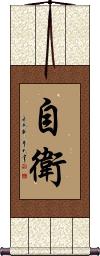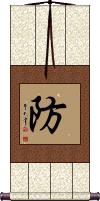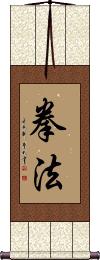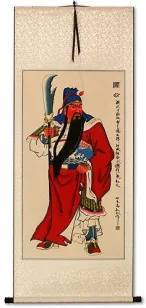Many custom options...
And formats...

Defense in Chinese / Japanese...
Buy a Defense calligraphy wall scroll here!
Personalize your custom “Defense” project by clicking the button next to your favorite “Defense” title below...
Self-Defense
Defense / Defend
防 is a single Chinese character and Korean Hanja that means to protect, defend, guard against, prevent, ward off, or counter.
防 means the same thing in Japanese, though seldom seen alone as a single Kanji. When written alone, it could be the Japanese surname Fusegi.
Kenpo / Kempo / Quan Fa / Chuan Fa
拳法 is a form of martial arts that can be translated in several ways.
Some will call it “fist principles,” “the way of the fist,” or even “law of the fist.” The first character literally means fist. The second can mean law, method, way, principle, or Buddhist teaching.
Kempo is really a potluck of martial arts. Often a combination of Chinese martial arts such as Shaolin Kung Fu with Japanese martial arts such as Karate, Jujutsu (Jujitsu), Aikido, and others. You may see the term “Kempo Karate,” which basically means Karate with other disciplines added. In this way, Kempo becomes an adjective rather than a title or school of martial arts.
These facts will long be argued by various masters and students of Kempo. Even the argument as to whether it should be spelled “kenpo” or “Kempo” ensues at dojos around the world (the correct Romaji should actually be “kenpou” if you precisely follow the rules).
The benefit of Kempo is that the techniques are easier to learn and master than pure Kung Fu (wu shu). Students are often taught basic Karate moves, kicks, and punches before augmenting the basic skills with complex Kung Fu techniques. This allows students of Kempo to achieve a level where they can defend themselves or fight in a relatively short amount of time (a few years rather than a decade or more).
Because the definition of this word is so fluid, I should make some notes here:
1. Purists in Okinawa will claim that “Okinawa Kenpo” or “Ryukyu Hon Kenpo” is the original and true version of this martial art from the old kingdom. It is actually little or no connection between Okinawa Kenpo and the way the word is used elsewhere.
2. In Chinese, where these characters are pronounced “quan fa” (sometimes Romanized as “chuan fa” because the Chinese-pinyin “q” actually sounds like an English “ch” sound), these characters do not hold the connotation of being a mixed martial art. It is simply defined as “the law of the fist.”
3. My Japanese dictionary oddly defines Kenpo as the “Chinese art of self-defense.” I personally don't feel this is the most common way that people perceive the word but just something you should know.
Furinkazan
military strategy
風林火山 is the battle strategy and proverb of Japanese feudal lord Takeda Shingen (1521-1573 AD).
This came from the Art of War by Chinese strategist and tactician Sun Tzu (Sunzi).
You can think of this as an abbreviation to remind officers and troops how to conduct battle.
風林火山 is a word list: Wind, Forest, Fire, Mountain.
The more expanded meaning is supposed to be...
“Swift as the wind, quiet as the forest, fierce as fire, and immovable as a mountain”
“As fast as the wind, as quiet as the forest, as daring as fire, and immovable as the mountain”
“Move as swift as the wind, stay as silent as a forest, attack as fierce as fire, undefeatable defense like a mountain”
“Move swiftly like the wind, stay silent like the forest, attack fiercely like fire, take a tactical position on the mountain”
See Also: Art of War
This in-stock artwork might be what you are looking for, and ships right away...
These search terms might be related to Defense:
Alert / on Guard / Lingering Mind
Blessings and Protection
Divine Protection
Guard
Police / Public Security Bureau
Protect Guard Treasure Cherish
Protection
Sorry / Apology
Under the Protection of the Dragon Saint
Not the results for defense that you were looking for?
Below are some entries from our dictionary that may match your defense search...
| Characters If shown, 2nd row is Simp. Chinese |
Pronunciation Romanization |
Simple Dictionary Definition |
武術 武术 see styles |
wǔ shù wu3 shu4 wu shu bujutsu ぶじゅつ |
More info & calligraphy: Martial Arts / Wushu(1) martial arts; military arts; (2) (See 武術太極拳) wushu (Chinese martial art) |
自衛 自卫 see styles |
zì wèi zi4 wei4 tzu wei jiei / jie じえい |
More info & calligraphy: Self-Defense(n,vs,vt,vi,adj-no) self-defense; self-defence |
薩德 萨德 see styles |
sà dé sa4 de2 sa te |
More info & calligraphy: Thad |
護身術 see styles |
goshinjutsu ごしんじゅつ |
More info & calligraphy: Goshin Jutsu |
檑 see styles |
léi lei2 lei |
logs rolled down in defense of city |
DF see styles |
dii efu; diiefu / di efu; diefu ディー・エフ; ディーエフ |
(1) {sports} (See ディフェンダー) defender; (2) {sports} (See ディフェンス) defence; defense; (3) (See 食物繊維) dietary fiber; (4) (See 方向探知器) direction finder |
J隊 see styles |
jeitai / jetai ジェイたい |
(slang) (See 自衛隊・1) Japan Self-Defense Forces; JSDF |
MD see styles |
emu dii; emudii(sk) / emu di; emudi(sk) エム・ディー; エムディー(sk) |
(1) (See ミニディスク) minidisc; MD; (2) missile defense; MD; (3) magnetic disk; MD; (4) (See マーチャンダイジング) merchandising |
保衛 保卫 see styles |
bǎo wèi bao3 wei4 pao wei yasue やすえ |
to defend; to safeguard (noun/participle) defense; defence; protection; safeguard; (given name) Yasue |
刀塔 see styles |
dāo tǎ dao1 ta3 tao t`a tao ta |
Defense of the Ancients (DotA), video game |
分洪 see styles |
fēn hóng fen1 hong2 fen hung |
to separate flood; flood defense |
受け see styles |
uke うけ |
(n,n-suf) (1) popularity; favour; favor; reception; (2) defense; defence; reputation; (3) agreement; (4) receiver of technique (e.g. in martial arts); (5) (kana only) (colloquialism) submissive partner of a homosexual relationship |
固め see styles |
katame かため |
(1) hardening; fortifying; (2) pledge; vow; (3) defense; defence; guarding |
国選 see styles |
kokusen こくせん |
(noun - becomes adjective with の) (See 私選・1) selection by the state (esp. of a defense lawyer); appointment; assignment |
国防 see styles |
kokubou / kokubo こくぼう |
national defence; national defense |
國防 国防 see styles |
guó fáng guo2 fang2 kuo fang |
national defense See: 国防 |
城防 see styles |
chéng fáng cheng2 fang2 ch`eng fang cheng fang |
city defense |
堅守 坚守 see styles |
jiān shǒu jian1 shou3 chien shou kenshu けんしゅ |
to hold fast to; to stick to (noun, transitive verb) strong defense; strong defence |
塔防 see styles |
tǎ fáng ta3 fang2 t`a fang ta fang |
(gaming) tower defense |
守り see styles |
mamori まもり |
(1) babysitting; babysitter; (2) protecting; keeping; keeper; (1) protection; defense; defence; (2) providence; (3) (abbreviation) amulet; charm; talisman |
守備 守备 see styles |
shǒu bèi shou3 bei4 shou pei shubi しゅび |
to garrison; to stand guard; on garrison duty (n,vs,vt,adj-no) (1) (ant: 攻撃・1) defense; defence; (2) {baseb} fielding |
守刀 see styles |
mamorigatana まもりがたな |
(irregular okurigana usage) sword for self-defense; sword for self-defence |
守戦 see styles |
shusen しゅせん |
war of defense; war of defence; defensive fight; defensive warfare |
守敵 守敌 see styles |
shǒu dí shou3 di2 shou ti |
enemy defense; enemy garrison |
布防 see styles |
bù fáng bu4 fang2 pu fang |
to lay out a defense |
座技 see styles |
suwariwaza すわりわざ |
{MA} Aikido seated defence (defense) |
弁疏 see styles |
benso べんそ |
(noun, transitive verb) excuse; plea; defense; defence |
弁解 see styles |
benkai べんかい |
(n,vs,adj-no) justification; rationalization; pretext; explanation; exculpation; defence; defense; excuse; apology |
弁護 see styles |
bengo べんご |
(noun/participle) defense; defence; pleading; advocacy |
後技 see styles |
ushirowaza うしろわざ |
{MA} Aikido rear defence (defense) |
Click here for more defense results from our dictionary
The following table may be helpful for those studying Chinese or Japanese...
| Title | Characters | Romaji (Romanized Japanese) | Various forms of Romanized Chinese | |
| Self-Defense | 自衛 自卫 | ji ei / jiei | zì wèi / zi4 wei4 / zi wei / ziwei | tzu wei / tzuwei |
| Defense Defend | 防 | bou / bo | fáng / fang2 / fang | |
| Kenpo Kempo Quan Fa Chuan Fa | 拳法 | kenpou / kenpo | quán fǎ / quan2 fa3 / quan fa / quanfa | ch`üan fa / chüanfa / chüan fa |
| Furinkazan | 風林火山 风林火山 | fuu rin ka zan fuurinkazan fu rin ka zan | fēng lín huǒ shān feng1 lin2 huo3 shan1 feng lin huo shan fenglinhuoshan | |
| In some entries above you will see that characters have different versions above and below a line. In these cases, the characters above the line are Traditional Chinese, while the ones below are Simplified Chinese. | ||||
Successful Chinese Character and Japanese Kanji calligraphy searches within the last few hours...








